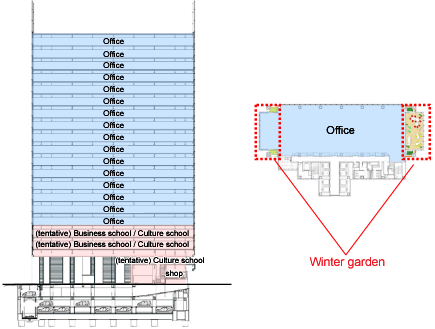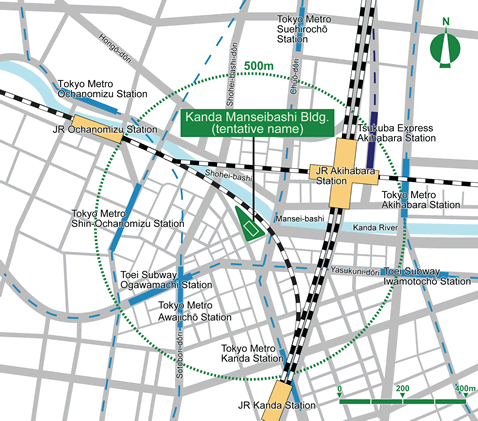Construction of Kanda Manseibashi Building (Provisional Name)
East Japan Railway Company
March 25, 2010
East Japan Railway Company (JR East) will build an eco–friendly rental office building in 1–chome, Kanda Suda–cho, Chiyoda–ku, Tokyo.
The plan will utilize the Chuo Line’s red brick viaduct as a scenic centerpiece and create open spaces such as pedestrian spaces and pathways that go through the premises.
The next–generation building will have exceptional environmental value with a "Winter Garden" on each floor with windows that can be opened.
External view
1. Plan concept and characteristics
| |
1) Plan concept |
| |
|
|
|
| |
|
• |
The location has long drawn visitors as the site of the former Manseibashi Station and the Transportation Museum, and the brick arched viaduct is a valuable historical asset. |
| |
|
|
|
| |
|
• |
The area is also expected to act as a meeting and exchange point connecting Akihabara Electric Town and the Kanda Suda–cho/Awaji–cho area, where a district of distinctive old shops remains today. The Kanda River, one of the few waterside spaces in the center of Tokyo, runs between the two areas. |
| |
|
|
|
| |
|
• |
In respect to these aspects of the neighborhood, we are planning this project along three main lines, which will maintain area history for a new generation and create new value: (1) development that is based on local and historical factors, (2) planning that is eco– and nature–friendly, and (3) planning that promotes exchange. |
| |
|
|
|
External appearance
| |
2) Plan characteristics |
| |
|
|
|
| |
|
(1) |
Development that is based on local and historical factors |
| |
|
|
• |
Considering that the area is a meeting point for the district, we will actively create open spaces connecting to the surrounding areas and make a new pedestrian space along the viaduct. |
| |
|
|
|
|
| |
|
|
• |
Because the plan is to use the red brick viaduct as a scenic centerpiece, the low–rise part will give a clear view of the viaduct and offer wide entrance spaces, while the high–rise part is designed with an awareness of the scenic value of the brick arches on the Kanda River side. |
| |
|
|
|
|
| |
|
|
• |
Reflecting the history of the site as the former home of Manseibashi Station (once the terminus of the Chuo Line) and the Transportation Museum, the exterior plan uses a railroad concept that elicits a feel for the area’s past. |
| |
|
|
|
|
Rendering of Brick Viaduct Pathway
| |
|
(2) |
Planning that is eco- and nature–friendly |
| |
|
|
• |
The plan for arranging the building, which incorporates green building concepts, will reduce its environmental footprint. The design aims to achieve an AAA rating, among the best in Tokyo, by seeking for example to achieve a PAL value (a measure of building insulation) at least 25% lower than ordinary buildings. |
| |
|
|
|
|
| |
|
|
• |
Each floor will have an area with windows that open, thus incorporating the "Winter Garden" concept found in eco–friendly construction in Europe and Australia. A "Winter Garden" is a comfortable place that contains greenery and lets the wind pass through to help reduce air conditioning use in spring and autumn. |
| |
|
|
|
|
| |
|
|
• |
To encourage environmentally responsible commuting, the building will offer bicycle parking and showers for tenants. |
| |
|
|
|
|
| |
|
|
• |
There will be plenty of greenery on the roof and eaves of the building. |
| |
|
|
|
|
| |
|
|
• |
The building seeks to acquire the highest rank (S Rank) under CASBEE (the Comprehensive Assessment System for Building Environment Efficiency). |
| |
|
|
|
|
| |
|
|
• |
The planner is also considering earning LEED–CS certification (an environmental performance standard) from the U.S. Green Building Council (USGBC). |
| |
|
|
|
|
Rendering of Winter Garden (area where windows can be opened)
| |
|
(3) |
Planning that promotes exchange |
| |
|
|
• |
The planner is considering locating shops and educational facilities for raising children on the lower floors of the building (floors 1 – 4) to make it a place that connects the surrounding area and helps people conduct their activities. |
| |
|
|
|
|
Facility configuration and standard floor plan
| |
3) Other characteristics and access |
| |
|
|
|
| |
|
• |
Each standard floor will contain about 950 m² (about 290 tsubo) of rental space without interior posts or columns. For security, the building will have a building entry control system using Suica. |
| |
|
|
|
| |
|
• |
The new development will be available to users of three JR stations located within 500 meters of it: Akihabara (Sobu, Yamanote and Keihin Tohoku lines), Kanda (Chuo, Yamanote and Keihin Tohoku lines) and Ochanomizu (Chuo and Sobu lines). There are in addition seven more stations: Awajicho, Kanda, Akihabara and Shin–Ochanomizu of the Tokyo Metro subway system; Ogawamachi and Iwamotocho on the Toei subway system; and Tsukuba Express Akihabara Station. All together, these 10 stations make the area extremely convenient for transportation purposes. |
| |
|
|
|
2. Facility overview
| |
|
|
|
|
| |
1. |
Location |
: |
25, 1–chome, Kanda Suda–cho, Chiyoda–ku, Tokyo |
| |
|
|
|
|
| |
2. |
Construction |
: |
Steel frame |
| |
|
|
|
|
| |
3. |
Floors / height |
: |
Floors: 20 above ground, 2 below / Height: about 100 m |
| |
|
|
|
|
| |
4. |
Total floor area |
: |
About 28,000 m² (Tokyo ordinary general design system will apply) |
| |
|
|
|
|
| |
5. |
Usage configuration |
: |
Rental offices, shops, business school (tentative), cultural school (tentative) Automobile parking (about 80 vehicles) |
| |
|
|
|
|
| |
6. |
Designer |
: |
JR East Design Corporation |
| |
|
|
|
|
| |
7. |
Operating company |
: |
JR East Building Co., Ltd. |
| |
|
|
|
|
| |
8. |
Schedule |
: |
Start of construction: around June 2010 (planned), Opening: around December 2012 (planned) |
| |
|
|
|
|
Locator map
* |
All the plans and images above are valid at the current time, but is subject to change with further study. |





